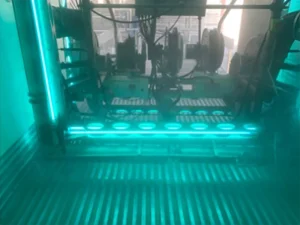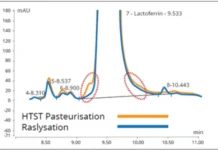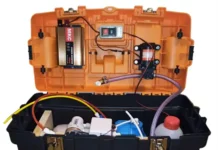
By Pam Young, Healthy Trailer, LLC
The transportation machinery that moves the world’s food is delicate and intricate. Continuous monitoring of critical logistic events is the key to meeting consumers’ demands for safe fresh and frozen foods. These demands layer the transportation process with challenges that stem from old “best practices,” various refrigeration devices and systems, and numerous sources of contamination that can expose these trailer environments to serious food safety risks.
In 2017, the US Food and Drug Administration (FDA) made enforceable the Sanitary Transportation Rule (STR). As part of the Food Safety Modernization Act (FSMA), this rule is significant because it is the primary means to keeping food safe from Farm to Fork.
Because of these factors that contribute to potential contamination risks, sanitary transportation is not only a federal requirement, but also a key component for safeguarding the vast investments food companies make when they create, produce, market and sell food to consumers.
Already proven and useful in many industries, the power and consistency of germicidal UV-C is one of the most effective means to disinfect a very challenging environment – the interior of a refrigerated food transport trailer.
Risks related to transportation realities
Most people visualize food transportation as a shipment actually in transit. But how do the other events and activities related to transportation contribute to contamination risks? What in the actual design of a refrigerated trailer might harbor contamination and dangerous pathogens?
First, a quick look inside a trailer is helpful to appreciate how the structural design of trailers contributes to contamination risks.
Most perishable food today, particularly in the US, is transported in refrigerated trailers. The design of a typical 53-foot trailer includes a grooved floor that aids in the distribution of air. In the nose of the trailer, the floor often is recessed and connects tightly with the front wall, which is called the bulkhead. In many trailers, manufacturers install drain holes on each side of the trailer so that water collected during transit or cleaning can drain properly.
The refrigeration system includes a chute that is connected to a mechanical device that heats or cools air. Shipments of lettuce, broccoli and celery, for example, are maintained at 34° F to 36° F. An area called the threshold is at the tail of the trailer, and this section also includes drain holes.
Air, water and debris all can carry contamination risks that collect in or near each of these trailer components. Sometimes these risks are visible, but not always. Consider the air flow as the system distributes warm or chilled air continuously throughout the trailer during transit. Knowing the risks associated with recycled air, it is likely that the air is distributing microorganisms on the trailer surfaces and food products.
Second, food cargo – both current and prior – can contribute contamination. A common misconception about cargo is that only protein-based foods like meat, egg and dairy products can present food safety risks, but this ignores problems created by sugary deposits left from compromised packaging on products such as soft drinks and bakery goods. It is not uncommon to find fresh-produce remnants left in trailers after a load is delivered. Wood pieces from broken pallets and packaging materials are additional sources of potential contamination.
Third, people involved in transportation activities expose the trailer environment to microbial risks. Truck drivers, shipping facility inspectors and loaders enter and exit the trailer numerous times during the loading process. A study about the transfer of germs, specifically Escherichia coli, from shoes to walking surfaces is an example of how trailer floors can be exposed to dangerous human pathogens that cause foodborne-illness outbreaks.
Last, loading and unloading equipment is a possible source of contamination. Forklifts carry product from staging areas into trailers. Often, personnel are loading at least two trailers simultaneously, so it’s likely that there are instances of cross-contamination of bacteria from one trailer to the other via forklift tires.
Up until a few years ago, there were few instances of known total plate count (TPC) or adenosine triphosphate (ATP) sampling of trailer surfaces. This is because food transportation stakeholders have operated under two significant assumptions.
First, trailer surfaces are not food-contact surfaces so evaluation of risk is not necessary. However, once food transportation became part of FSMA and was included in the overall preventative food safety scheme, trailer surfaces should be considered Zone 2 or Zone 3 surfaces that require a SSOP to maintain sanitary conditions in a refrigerated trailer.
Second, it’s often assumed that packaging around food serves as a protective barrier during transportation. As long as the packaging completely encloses the food and does not get torn or broken so that food can be exposed to contamination risks, then this would be a sound assumption.
Unfortunately, compromised packaging is not uncommon in food shipments. It is estimated that damaged packaging contributes up to 30% of food waste in the supply chain. If FSMA requires its stakeholders to use preventative measures to protect food, then it should be assumed that broken packaging can contribute to trailer-contamination risks.
Accepting the fact that trailer environments and transportation activities can create risks to food, what are the options available to FSMA stakeholders to mitigate these risks?
Current trailer sanitation “best practices”
In the last issue of UV Solutions (2022 Quarter 3), Paul C. Waldeck noted that changes in regulations governing heating, ventilation and air conditioning systems have been implemented, but that the requirements are “not prescriptive.”
This is true in regard to the FDA’s STR. The rule acknowledges that food can become unsafe during transportation activities, which have been outlined in this article. But rather than giving specific standards to define how to maintain a “clean and sanitary” trailer, the FDA took the position that the stakeholders should use “best practices” to prevent food from becoming unsafe during transportation. Unlike other food safety protocols, transportation SSOPs are not risk- or science-based.
First, the “clean and sanitary” standard means that an inspector used the “see and smell test” to determine cleanliness: If there is no odor and the trailer looks clean, it is ready to transport food. During the check-in process, a driver is asked if the trailer is clean. Some facilities and shippers require that the driver verify that a trailer has been washed out, but it’s not always required that any document confirms the washout procedure.
Second, depending on the shipper’s cleaning requirements, visible debris in the trailer will have been removed with one of three tools: A broom, a leaf blower or a water hose/pressure washer. All three of these options make sense under the current best practice standard using the clean and smell test. Drivers sweeping, blowing and washing their debris out into the environment raises sustainability issues.
Third, and probably the most risk-prone step in the process, chemicals often are used as the sanitizing step that is intended to ensure the trailer is ready for a food shipment. This is a problem for several reasons, primarily due to the application process. In most situations, an employee has washed out the trailer manually. This is not typically a standardized protocol but rather a hosing down of areas that are visibly dirty. A food-grade quaternary ammonium compounds (quat) is applied throughout the trailer, usually only on the floors.
The specific issues with this chemical application include the following:
- Employees apply chemicals in uncleaned areas, creating the opportunity for biofilms to develop.
- The floor is the primary focus in application, leaving walls and ceilings unsanitized.
- The chemical application is not applied according to the instructions.
- It is not unusual to have chemical residue remaining in the trailer.
- Improper use of chemicals makes use unsafe for the employees and food cargo.
While brooming and sweeping rarely should be used as a trailer sanitation practice, a water washout with a chemical application could be an effective process if both the washout and the chemical application are completed according to a risk-based, science-based SSOP.

Is UV-C a trailer sanitation option?
There are a growing number of food companies that are acknowledging their concerns about the cleanliness of the transport trailers used to haul their valuable food products. But as is often the case when any change is necessary, companies that want to strengthen their food safety programs with improved trailer-sanitation practices must consider the impact of these changes on their logistical operations.
In FSMA transportation, specifically in trailer sanitation, there is a tension between the process itself, making sure it is effective and repeatable, and the impacts of the process, in terms of sustainability and costs.
Is UV-C an effective, repeatable protocol for food transport trailers?
When a trailer arrives to be cleaned, there is not a method of determining the ‘invisible’ contamination level. Inspections during the pre-clean process (for example, debris in the trailer, damage to surfaces and components) that include gathering information about prior cargo and past washouts can provide indications about the sanitary conditions of the trailer.
Given that the method of using UV-C is proven and documented, it also is a sustainable, environmentally friendly and chemical-free process that effectively provides a trailer environment safe for food transport.
The challenge then becomes how best to apply this technology in a trailer environment. The process involves getting the surfaces clean so that the UV application can sanitize the surface, understanding where contamination most likely connects so that the light can be adequately directed to reach those areas, and routinely maintaining and monitoring the system so the lamps are operating correctly.
Designed and built to address these challenges, Healthy Trailer’s machine delivers a preclean wash through its water distribution system, spraying minimal water that cleans the trailer’s surfaces. Ten sets of germicidal UV lamps, positioned in arrays around the machine that expose the floor, bulkhead, ceiling and walls of the trailer, are operated during the wash cycle and then during a 12- to 15-minute disinfection cycle of UV-C. The UV system is validated and verified using TPC sampling and dosimeter cards, and it is evaluated based on food safety professionals’ suggestions that trailer surfaces most likely are a Zone 2 or Zone 3 surface for purposes of validating SSOPs.
While using this technology to help FSMA stakeholders meet and exceed compliance with “clean and sanitary” requirements is already proving to be a valuable investment, there will always be more to learn about how best to use this technology.
Further reading
FSMA/Sanitary Transportation Rule,
https://www.fda.gov/about-fda/economic-impact-analyses-fda-regulations/summary-sanitary-transportation-human-and-animal-food-final-rule
Shoe Study by Charles P. Gerba, professor and microbiologist, University of Arizona, https://www.nytimes.com/2019/08/27/science/shoes-in-house-germs.html
Food waste in the supply chain,
Pam Young is an experienced food transportation service provider, specializing in helping customers maximize their FSMA transportation compliance programs. A co-founder of Healthy Trailer, LLC, she works as the managing director in overseeing the development and placement of the patented Healthy Trailer system and its service sites. She also owns Pam Young & Company, Inc., a truck brokerage specializing nationwide fresh produce shipments. For more information, call 831.262.9825 or email pamyoung@healthytrailerllc.com.





